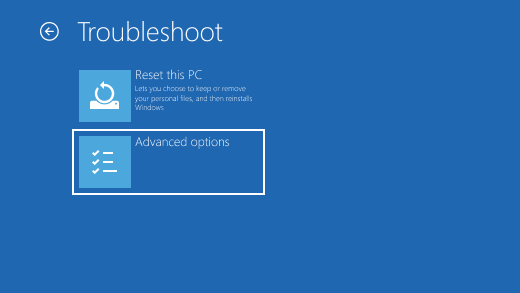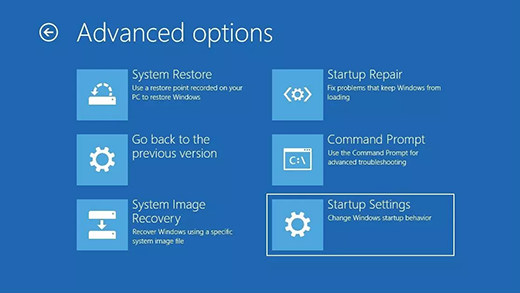It's
not always obvious what may have caused a blue screen error while you
are using your device, it may be that you're using new hardware or
third-party software that isn't compatible with your Windows device. Use
the following troubleshooting steps in order to try and fix your blue
screen error.
Step 1: Uninstall third-party software
Some
third-party antivirus software has been known to cause blue screen
errors. You can temporarily uninstall this software to determine if it
is causing your issue, and then reinstall the software after your device
is back up and running.
To
do this, you'll need to sign in to Windows using safe mode. Safe mode
starts Windows in a basic state, using a limited set of files and
drivers and allows you to perform troubleshooting steps.
Before you enter safe mode, you need to enter the Windows Recovery Environment (WinRE ). Here’s how:
-
Hold down the power button for 10 seconds to turn off your device.
-
Press the power button again to turn on your device.
-
On the first sign that Windows has started
(for example, some devices show the manufacturer’s logo when restarting)
hold down the power button for 10 seconds to turn off your device.
-
Press the power button again to turn on your device.
-
When Windows restarts, hold down the power button for 10 seconds to turn off your device.
-
Press the power button again to turn on your device.
-
Allow your device to fully restart to enter WinRE.
Now that you are in WinRE, follow these steps to take you to safe mode.
Note: If you’ve encrypted your device, you’ll need your BitLocker key to start in safe mode.
-
On the Choose an option screen, select Troubleshoot > Advanced options > Startup Settings > Restart.




-
After your device restarts, you'll see a list of options. The preferred option is to select 5 or press F5 for Safe Mode with Networking.
Once your device is in safe mode, select the Start button, then select Settings > System > Apps & features. Select Sort by name and change it to Sort by install date. Select the third-party software you want to remove, and then select Uninstall. After you uninstall the third-party software, restart your device.
Notes: If you need to exit safe mode, here's how:
-
Press the Windows logokey + R.
-
In the Open box, type msconfig, and then select OK.
-
Select the Boot tab.
-
Under Boot options, clear the Safe boot check box.
If you're still seeing a blue screen error, try rolling back, disabling, or uninstalling the recently installed drivers.
Step 2: Rollback, disable, or uninstall drivers
If
you recently installed new drivers, you can rollback, disable, or
uninstall them to determine if that's what's causing your issue.
First, make sure your device is in safe mode, and then use Device Manager to either rollback, disable, or uninstall drivers.
Note: You must have administrator privileges to rollback, disable, or uninstall a device or driver package by using Device Manager.
Rollback third-party drivers
-
In the search box on the taskbar, type device manager, and then select Device Manager from the list of results.
-
In Device Manager, expand the device that has the driver you want to rollback, right-click the driver under the device, and then select Properties.
-
Select the Driver tab, and then select Roll Back Driver > Yes.
Note: If the Roll Back Driver option is unavailable, Windows doesn't have a previous driver to roll back to and you won't be able to complete this process.
If you weren't able to roll back your driver or if you're still seeing a blue screen error, try disabling the driver.
Disable third-party drivers
-
In the search box on the taskbar, type device manager, and then select Device Manager from the list of results.
-
In Device Manager, expand the device that has the driver you want to disable, right-click the driver under the device, and then select Properties.
-
Select the Driver tab, and then select Disable device > Yes.
If you're still seeing a blue screen error, try uninstalling the driver.
Uninstall third-party drivers
-
In the search box on the taskbar, type device manager, and then select Device Manager from the list of results.
-
In Device Manager, expand the device that has the driver you want to uninstall, right-click the driver under the device, and then select Properties.
-
Select the Driver tab, and then select Uninstall > OK.
Notes:
-
You may need to select Delete the driver software for this device in the Confirm Device Removal box, and then select Uninstall > OK.
-
With some devices, you may have to restart your device to complete the uninstall process.
If you're still seeing a blue screen error, try uninstalling removing your external hardware.
Step 3: Remove external hardware
Sometimes,
your device’s external devices can be the cause of blues screen stop
errors. Unplug any external storage devices and drives, docks, and other
hardware plugged into your device that isn’t needed for basic
functionality, and then restart your device.
If
you don't experience the issue after restarting your device,
the external device may be the cause of the problem, and you'll need to
contact your device manufacturer for support.




